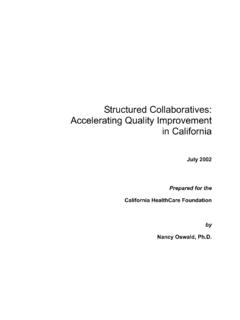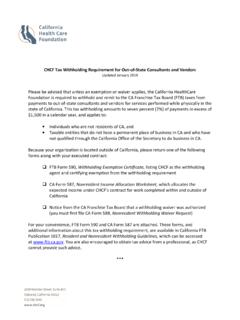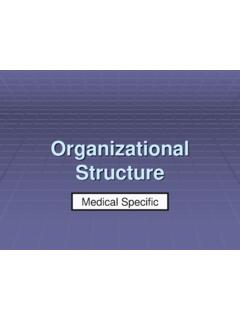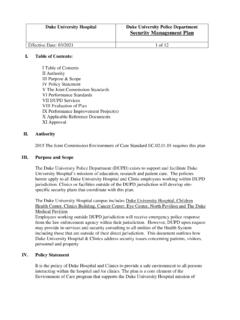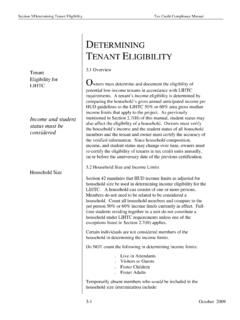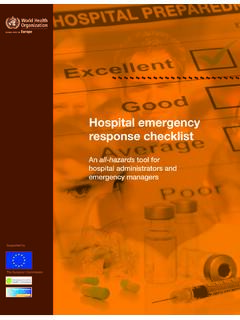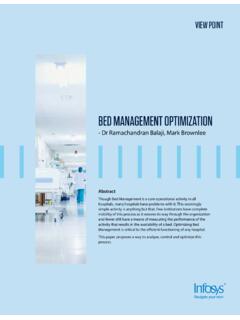Transcription of Understanding the Hospital Planning, Design, and ...
1 IntroductionCalifornia s acute care hospitals are an essential health care resource that serve a wide range of patients during times of illness or injury. To do so properly, they must be well designed, safe, and efficient. Recent Hospital construction planning in response to the seismic safety mandates of SB 1953 will require many Hospital boards of directors to oversee major building projects. Because such projects are relatively infrequent, board members and leaders may have only limited experience with the many complexities and challenges involved in the planning, design, and construction of a Hospital facility.
2 This issue brief is intended to acquaint non-experts with the way in which Hospital construction projects are developed and delivered. BackgroundThe Hospital planning, design, and construction process takes the form of three distinct first is the definition and planning for the Hospital project itself, including the project request, strategic plan, facilities needs assess-ment, specific program, and concept is the preparation of schematic design, design development, construction documentation, and securing a building permit.
3 This phase involves two public agencies: the city or county for land use approval, and the Office of Statewide Health Planning and Development Facilities Development Division (OSHPD FDD) for the building permit and subsequent construction observation. See page 5 for descriptions of these agencies. The third phase covers bidding, construction, licensing, and evaluation. Licensing is provided by the Department of Health Services and the California Health and Human Services Agency. Only with their approval can the Hospital operate and be eligible for Medicare and Medical of the Hospital planning, design, and construction process is depicted on the flow chart on page 2.
4 The chart is based upon major projects or extensive re-builds which typically take seven or eight years to complete. Smaller projects, such as interior remodeling, use the same process but may not require the land use approval 1: Project Definition and PlanningProject Request: All hospitals should have a process to identify construction projects and requests. Smaller projects are often a part of the routine planning and budgeting process; larger projects typically require focused attention and consideration within the context of the Hospital s longer range strategic and capital planning Plan: Most Hospital construction projects are the result of either changes in Understanding the Hospital Planning, Design, and Construction ProcessISSUE BRIEFFEBRUARY 20072 | CALIFORNIA HEALTHCARE FOUNDATIONthe numbers of patients served, new treatments, or technologies, or strategic initiatives that further the Hospital s mission.
5 All hospitals should have a strategic plan that has been developed with the partic-ipation of Hospital s administration, professional staff, patients, physicians, and the board of directors. The plan should address the patient care and community service goals for a period of at least five years. The proposed building projects encompassed within the strategic plan should both allow the Hospital to grow Project Request Strategic Plan Needs AssessmentFigure 1: Elements of a Hospital Building Project PHASE 1 City Land Use Permit ProcessSchematic DevelopmentOSHPD Building Permit ProcessPHASE 2 PHASE 3 Specific Program Concept DesignDesign DevelopmentConditional Use Permit and Environmental Impact Report SubmissionPreliminary SubmittalPublic HearingsBuilding Permit SubmittalConstruction DocumentsBuilding PermitInspectionBidding/ConstructionLice nsing/OccupancyEvaluationLand Use ApprovalPlanning, Design.
6 And ConstructionBuilding Permit ApprovalUnderstanding the Hospital Planning, Design, and Construction Process | 3and improve the treatment of patients through the introduction of new equipment or services, develop-ment of key departments, and compliance with Senate Bill 1953 for seismic upgrades, which may require major additions or even Hospital replacement. Any new project should be reviewed internally to determine whether it is consistent with the strategic plan. Facility Needs Assessment: Intrinsic to the strategic plan is the facility needs assessment.
7 This evaluates each of the departments in the Hospital to determine how they are meeting their current and potential future workloads. These workload forecasts generate space requirements that form the basis for future remodel-ing or additions that accommodate changing needs. Service lines may need clarification or re-definition. A technology plan should be reviewed and updated. These needs can then be prioritized to become a road map for fiscal and building development. The needs assessment should also include a master facilities plan.
8 This plan can assist in predicting when a proposed project may trigger upgrades of mechanical, electrical, plumbing, and structural systems as well as assist in determining where additional sources of power are required. Facility needs assessments should be updated Program: Once a proposed project has been identified, a specific program should be developed to define the space needs and major equipment for each of the departments affected. The space requirements are driven by the number of medical procedures or services in each area, plus the area necessary for circu-lation, waiting, handicapped access requirements, and toilets.
9 A staffing model, material flow diagrams, staff and patient flow diagrams, and related services and adjacencies are also considered. Percentage factors are applied for mechanical equipment space, net-to-gross square footage ratios, and exit ways such as stairs and elevators. Often, the Department of Health Services (which will subsequently license the project) reviews the staffing model and program. The specific program is then tested against the strategic plan and the facilities needs assessment. Depending on the complexity of the project, this is the time to select an architect with appropriate engineering consultants.
10 Some firms provide the programming services above, but most hospitals should select their design team no later than the completion of programming. It is essential that the architect be experienced in the design of California hospitals and has extensive experience working with OSHPD FDD. Concept Design: Upon approval of the specific program, a concept design is prepared that develops the available space into floor plans, interior elevations, stacking and blocking diagrams, building sections, exterior elevations, and a site plan.







